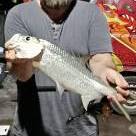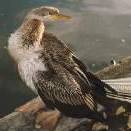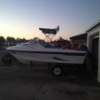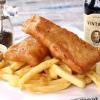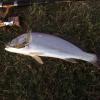-
Content Count
452 -
Joined
-
Last visited
-
Days Won
23
Reputation Activity
-
 Soobz got a reaction from Wert in Braid: Strength vs Diameter vs PE
Soobz got a reaction from Wert in Braid: Strength vs Diameter vs PE
In the interests of science I tried to measure some braids on a digital microscope. I don't think it's too accurate at measuring so don't take the numbers on face value, and I'm very new to this camera so it's not great imaging at these zooms, so, these are not under any significant tension which may affect diameter a bit. But here's some photos for ya.
white = Tasline 12lb, supposed to be 0.128mm
yellow = Sufix 832 8lb, supposed to be 0.18mm
green = Sufix 832 30lb, supposed to be 0.29mm
silver = 0.35mm solder. I put this in as a ref because it was measurable by calipers and was 0.36mm on Moore and Wright (good brand)
I also calibrated the camera manually for some measurements using 0.25mm on the calipers.
Yellow text is hard to read on some sorry, so I'll type underneath
50x zoom, manual cal, 0.349 = solder, 0.321/0.310,0.236/0.252,0.246/0.252
132x zoom, 0.300, 0.228, 0.223
I think all I can really take from this is 8lb Sufix 832 is pretty much the same size as Tasline 12lb, which makes sense since Tasline say theirs really is more like 20.6lb and Sufix EU say theirs is more like 26lb. BTW the 0.3mm 832 is 50lb in the EU. And as much as I know the measurements aren't accurate I reckon Tasline might be taking the piss with .128mm, but I did fit 300m on my Vanford 2500 so then again it's under 0.18
-
 Soobz got a reaction from yellow door 1 in Braid: Strength vs Diameter vs PE
Soobz got a reaction from yellow door 1 in Braid: Strength vs Diameter vs PE
In the interests of science I tried to measure some braids on a digital microscope. I don't think it's too accurate at measuring so don't take the numbers on face value, and I'm very new to this camera so it's not great imaging at these zooms, so, these are not under any significant tension which may affect diameter a bit. But here's some photos for ya.
white = Tasline 12lb, supposed to be 0.128mm
yellow = Sufix 832 8lb, supposed to be 0.18mm
green = Sufix 832 30lb, supposed to be 0.29mm
silver = 0.35mm solder. I put this in as a ref because it was measurable by calipers and was 0.36mm on Moore and Wright (good brand)
I also calibrated the camera manually for some measurements using 0.25mm on the calipers.
Yellow text is hard to read on some sorry, so I'll type underneath
50x zoom, manual cal, 0.349 = solder, 0.321/0.310,0.236/0.252,0.246/0.252
132x zoom, 0.300, 0.228, 0.223
I think all I can really take from this is 8lb Sufix 832 is pretty much the same size as Tasline 12lb, which makes sense since Tasline say theirs really is more like 20.6lb and Sufix EU say theirs is more like 26lb. BTW the 0.3mm 832 is 50lb in the EU. And as much as I know the measurements aren't accurate I reckon Tasline might be taking the piss with .128mm, but I did fit 300m on my Vanford 2500 so then again it's under 0.18
-
 Soobz reacted to Wert in Braid: Strength vs Diameter vs PE
Soobz reacted to Wert in Braid: Strength vs Diameter vs PE
Braid breaking strains and diameters I'm pretty sure are allocated via a random number generator. Through much trial and error I've found siglon PE8 seems to have the most accurate stated breaking strains and is way thinner and smoother than any others rated the same so I use it because I know what I'm getting.
I suspect the only true answer to this braid conundrum is do your own legwork and hopefully you find what you like.
This is why I will pay a little more and shop at brick and mortar tackle shops most of the time, being able to physically touch, feel and compare before you buy is just so worth the small premium.
-
 Soobz reacted to yellow door 1 in Braid: Strength vs Diameter vs PE
Soobz reacted to yellow door 1 in Braid: Strength vs Diameter vs PE
Yeah with all the lines I was interested in at the time - his results lined up my suspicions - if I though a line was thicker than stated - his results would show it - if I thought a line was much stronger - same - if I thought a line was slightly weaker than other lines from the same company - his results would show that too.........
So I just trusted what he had written as gospel because it supported all my hunches and made me think I was a bit of a genius for being able to spot these minor differences by eye, feel and using the force😉
-
 Soobz got a reaction from yellow door 1 in Braid: Strength vs Diameter vs PE
Soobz got a reaction from yellow door 1 in Braid: Strength vs Diameter vs PE
Yeah, his site is up but not showing the results. But you can see the archived versions ,they are out of date and are missing some of the modern favourites. Also he was sloppy with filling out the table accurately, eg. .he says Sufix 6lb is 1.8mm, he probably means .18mm but that's Sufix 8lb - which he tested at 24lb but measures it at .22m (I get .18 on my 8lb which is it's spec) and the 6lb should be 0.13mm, so I do wonder how he came up with his numbers.
-
 Soobz got a reaction from keenfisho in Braid: Strength vs Diameter vs PE
Soobz got a reaction from keenfisho in Braid: Strength vs Diameter vs PE
I keep having to look this up so I thought I'd produce a guide I can refer back to, and maybe it helps others.
Many would know braid labelled strength vs diameter is all over the place in AU, with seemingly no consistency.
The reason for this is the US market decided they would label braid based on the mono equivalent size rather than it's true breaking strength, except they didn't really do that and it's a seemingly meaningless number. In Europe they generally label with the actual breaking strain. Australia seems to have gotten a mishmash.
eg. JBraid x8 0.13mm (from the labels)
EU = 8kg
AU = 3.8kg/8lb
US = 8lb
All of them are made in Japan, same factory, why is the EU one 2x stronger? Because it's not, they are all the same line. Also, 8lb mono would be more like 0.25mm, so it's not even like it's truly a mono equivalent number.
I use Tasline for my Vanford 2000, their 12lb is 0.128mm (yeah right, like they can measure a non round braid to 0.001mm), and they state they expect it to break at 20.6lb or 9.3kg, so at least you get an idea of what it's really intended to hold. I have not had one single wind knot with that 'thin as hell miles casting line', unlike the JBraid that I've had a few with.
Here's the charts I use now, it's Tasline's numbers, they tie up with somewhat similar number to Sufix 832, JBraid and Kairiki - at least a hell of a lot closer than the AU labels.
Test 8 lb 12 lb 15 lb 20 lb 30 lb 40 lb 50 lb 60 lb 80 lb 100 lb Diameter in mm 0.115 0.128 0.163 0.225 0.299 0.317 0.332 0.422 0.48 0.545 PE Rating 0.5 0.6 1 1.7 3 3.5 4 6 8 10 Actual Average Break 14.2 lb 20.6 lb 23.7 lb 34.7 lb 49.0 lb 59.2 lb 78.5 lb 91.6 lb 116.2 lb 138.2 lb
PE 0.6 ………………………….. 0.128mm PE 0.8 ………………………….. 0.148mm PE 1 …………………………….. 0.165mm PE 1.2 ………………………….. 0.185mm PE 1.5 ………………………….. 0.205mm PE 1.7 ………………………….. 0.218mm PE 2 …………………………….. 0.235mm PE 2.5 ………………………….. 0.260mm PE 3 …………………………….. 0.285mm PE 3.5 ………………………….. 0.310mm PE 4 …………………………….. 0.330mm PE 5 …………………………….. 0.370mm PE 6 …………………………….. 0.405mm PE 7 …………………………….. 0.435mm PE 8 …………………………….. 0.470mm PE 10 …………………………… 0.520mm
-
 Soobz got a reaction from gregtech in Braid: Strength vs Diameter vs PE
Soobz got a reaction from gregtech in Braid: Strength vs Diameter vs PE
I keep having to look this up so I thought I'd produce a guide I can refer back to, and maybe it helps others.
Many would know braid labelled strength vs diameter is all over the place in AU, with seemingly no consistency.
The reason for this is the US market decided they would label braid based on the mono equivalent size rather than it's true breaking strength, except they didn't really do that and it's a seemingly meaningless number. In Europe they generally label with the actual breaking strain. Australia seems to have gotten a mishmash.
eg. JBraid x8 0.13mm (from the labels)
EU = 8kg
AU = 3.8kg/8lb
US = 8lb
All of them are made in Japan, same factory, why is the EU one 2x stronger? Because it's not, they are all the same line. Also, 8lb mono would be more like 0.25mm, so it's not even like it's truly a mono equivalent number.
I use Tasline for my Vanford 2000, their 12lb is 0.128mm (yeah right, like they can measure a non round braid to 0.001mm), and they state they expect it to break at 20.6lb or 9.3kg, so at least you get an idea of what it's really intended to hold. I have not had one single wind knot with that 'thin as hell miles casting line', unlike the JBraid that I've had a few with.
Here's the charts I use now, it's Tasline's numbers, they tie up with somewhat similar number to Sufix 832, JBraid and Kairiki - at least a hell of a lot closer than the AU labels.
Test 8 lb 12 lb 15 lb 20 lb 30 lb 40 lb 50 lb 60 lb 80 lb 100 lb Diameter in mm 0.115 0.128 0.163 0.225 0.299 0.317 0.332 0.422 0.48 0.545 PE Rating 0.5 0.6 1 1.7 3 3.5 4 6 8 10 Actual Average Break 14.2 lb 20.6 lb 23.7 lb 34.7 lb 49.0 lb 59.2 lb 78.5 lb 91.6 lb 116.2 lb 138.2 lb
PE 0.6 ………………………….. 0.128mm PE 0.8 ………………………….. 0.148mm PE 1 …………………………….. 0.165mm PE 1.2 ………………………….. 0.185mm PE 1.5 ………………………….. 0.205mm PE 1.7 ………………………….. 0.218mm PE 2 …………………………….. 0.235mm PE 2.5 ………………………….. 0.260mm PE 3 …………………………….. 0.285mm PE 3.5 ………………………….. 0.310mm PE 4 …………………………….. 0.330mm PE 5 …………………………….. 0.370mm PE 6 …………………………….. 0.405mm PE 7 …………………………….. 0.435mm PE 8 …………………………….. 0.470mm PE 10 …………………………… 0.520mm
-
 Soobz reacted to Sykes in Happy Valley Reservoir opening in December
Soobz reacted to Sykes in Happy Valley Reservoir opening in December
I also think the tagging competition could be adding fuel to the fire. Everyone heading there, in for a chance.
-
 Soobz reacted to SurfcaztR in Happy Valley Reservoir opening in December
Soobz reacted to SurfcaztR in Happy Valley Reservoir opening in December
Complete chaos at Happy Valley reservoir.
A guy says seen 15 Cod caught in 15 mins from shore plus Cod being dragged out over ground and bagged,what a mess it has been over the weekend.plenty more shenanigans to come.
-
 Soobz got a reaction from doobie in Braid: Strength vs Diameter vs PE
Soobz got a reaction from doobie in Braid: Strength vs Diameter vs PE
I keep having to look this up so I thought I'd produce a guide I can refer back to, and maybe it helps others.
Many would know braid labelled strength vs diameter is all over the place in AU, with seemingly no consistency.
The reason for this is the US market decided they would label braid based on the mono equivalent size rather than it's true breaking strength, except they didn't really do that and it's a seemingly meaningless number. In Europe they generally label with the actual breaking strain. Australia seems to have gotten a mishmash.
eg. JBraid x8 0.13mm (from the labels)
EU = 8kg
AU = 3.8kg/8lb
US = 8lb
All of them are made in Japan, same factory, why is the EU one 2x stronger? Because it's not, they are all the same line. Also, 8lb mono would be more like 0.25mm, so it's not even like it's truly a mono equivalent number.
I use Tasline for my Vanford 2000, their 12lb is 0.128mm (yeah right, like they can measure a non round braid to 0.001mm), and they state they expect it to break at 20.6lb or 9.3kg, so at least you get an idea of what it's really intended to hold. I have not had one single wind knot with that 'thin as hell miles casting line', unlike the JBraid that I've had a few with.
Here's the charts I use now, it's Tasline's numbers, they tie up with somewhat similar number to Sufix 832, JBraid and Kairiki - at least a hell of a lot closer than the AU labels.
Test 8 lb 12 lb 15 lb 20 lb 30 lb 40 lb 50 lb 60 lb 80 lb 100 lb Diameter in mm 0.115 0.128 0.163 0.225 0.299 0.317 0.332 0.422 0.48 0.545 PE Rating 0.5 0.6 1 1.7 3 3.5 4 6 8 10 Actual Average Break 14.2 lb 20.6 lb 23.7 lb 34.7 lb 49.0 lb 59.2 lb 78.5 lb 91.6 lb 116.2 lb 138.2 lb
PE 0.6 ………………………….. 0.128mm PE 0.8 ………………………….. 0.148mm PE 1 …………………………….. 0.165mm PE 1.2 ………………………….. 0.185mm PE 1.5 ………………………….. 0.205mm PE 1.7 ………………………….. 0.218mm PE 2 …………………………….. 0.235mm PE 2.5 ………………………….. 0.260mm PE 3 …………………………….. 0.285mm PE 3.5 ………………………….. 0.310mm PE 4 …………………………….. 0.330mm PE 5 …………………………….. 0.370mm PE 6 …………………………….. 0.405mm PE 7 …………………………….. 0.435mm PE 8 …………………………….. 0.470mm PE 10 …………………………… 0.520mm
-
 Soobz got a reaction from Softy in Braid: Strength vs Diameter vs PE
Soobz got a reaction from Softy in Braid: Strength vs Diameter vs PE
I keep having to look this up so I thought I'd produce a guide I can refer back to, and maybe it helps others.
Many would know braid labelled strength vs diameter is all over the place in AU, with seemingly no consistency.
The reason for this is the US market decided they would label braid based on the mono equivalent size rather than it's true breaking strength, except they didn't really do that and it's a seemingly meaningless number. In Europe they generally label with the actual breaking strain. Australia seems to have gotten a mishmash.
eg. JBraid x8 0.13mm (from the labels)
EU = 8kg
AU = 3.8kg/8lb
US = 8lb
All of them are made in Japan, same factory, why is the EU one 2x stronger? Because it's not, they are all the same line. Also, 8lb mono would be more like 0.25mm, so it's not even like it's truly a mono equivalent number.
I use Tasline for my Vanford 2000, their 12lb is 0.128mm (yeah right, like they can measure a non round braid to 0.001mm), and they state they expect it to break at 20.6lb or 9.3kg, so at least you get an idea of what it's really intended to hold. I have not had one single wind knot with that 'thin as hell miles casting line', unlike the JBraid that I've had a few with.
Here's the charts I use now, it's Tasline's numbers, they tie up with somewhat similar number to Sufix 832, JBraid and Kairiki - at least a hell of a lot closer than the AU labels.
Test 8 lb 12 lb 15 lb 20 lb 30 lb 40 lb 50 lb 60 lb 80 lb 100 lb Diameter in mm 0.115 0.128 0.163 0.225 0.299 0.317 0.332 0.422 0.48 0.545 PE Rating 0.5 0.6 1 1.7 3 3.5 4 6 8 10 Actual Average Break 14.2 lb 20.6 lb 23.7 lb 34.7 lb 49.0 lb 59.2 lb 78.5 lb 91.6 lb 116.2 lb 138.2 lb
PE 0.6 ………………………….. 0.128mm PE 0.8 ………………………….. 0.148mm PE 1 …………………………….. 0.165mm PE 1.2 ………………………….. 0.185mm PE 1.5 ………………………….. 0.205mm PE 1.7 ………………………….. 0.218mm PE 2 …………………………….. 0.235mm PE 2.5 ………………………….. 0.260mm PE 3 …………………………….. 0.285mm PE 3.5 ………………………….. 0.310mm PE 4 …………………………….. 0.330mm PE 5 …………………………….. 0.370mm PE 6 …………………………….. 0.405mm PE 7 …………………………….. 0.435mm PE 8 …………………………….. 0.470mm PE 10 …………………………… 0.520mm
-
 Soobz reacted to vogon in KGW on SP? Lures?
Soobz reacted to vogon in KGW on SP? Lures?
Maybe, the headlockz one kept rolling over, which it mightn't do with line attached.
I haven't had much success with the Crawz as yet but it is early days. Had more luck with the creaturez & crusteaz
-
 Soobz reacted to MAH in My Squid Rig
Soobz reacted to MAH in My Squid Rig
I've posted a couple of reports of local land based squid fishing and thought I'd give a run down of the rig I use.
So lets get the obvious out of the way, you don't need anything fancy to catch squid, and a handline with a jig will catch you squid. However, if you are land based fishing from popular metro spots, there are some upgrades that will increase your chances.
Rod
Number one item I would suggest is a long rod capable of flinging a jig a long distance. Every man and his dog will be covering the same area with their casts, but if you can cast further and search an area others can't reach, you might just hook into that big squid no one else has been able to tempt. My rod of choice is an 8'9" medium heavy Emeraldas. These are nice quality rods, good blanks, Fuji K guides and a good action for squidding. I've tried a 9' medium NS Black Water and a 8'3" medium light Atomic Arrowz egi rod. The Emeraldas has been the best all round in terms of quality materials, build quality and performance, however I feel the NS Black Water was a better rod in terms of performance (particularly for price), but the build quality lacked a bit (the rod joint was a little too lose). I wouldn't buy an Emeraldas if I was paying the local price of $250 for the entry level model and would opt for the NS Black Water instead. But I bought a rod built for the European market from OS for $165 landed.
Line
After the rod i think the next important part is the line. Again, I'm mainly interested in casting distance, so a quality 8 strand braid is the way to go. I'm using Platypus P8 0.14mm, Australian made and owned, and there is an Ebay seller who usually has it for a good price. When I bought it, the guy chucked in for free a small bottle of Line Butter line conditioner. For leader material I use 15lb Duel HD fluorocarbon. Ideally you would use a lighter mainline and leader for both better distance and sensitivity, but it's a trade off with strength for pull jigs out of snags.
Reel
The reel isn't too critical for squid fishing, it's basically just a winch for dragging in the squid. However you do want a reel that allows line to come off easily for long casts and also lays the line evenly on the spool when retrieving the line. It's hard to go past either Shimano or Daiwa. My reel is an Emeraldas LT 2500 double handle, not necessary, but I paid only $153 including shipping. The drag on the Emeralds is well suited to squid fishing, as it's nice and progressive, so you can easily dial in the drag for different jigs. When whipping the rod up to make the jig hop, ideally you want the drag set so gives a little so when you strike you don't lose the squid from ripping out the jig out or ripping off a tentacle.
Jigs
In my opinion, jigs are the least critical part of the set-up. You can spend a fortune on jigs, but I think it's more important to have a selection of reasonable quality jigs rather than just a couple of expensive jigs. Firstly you will definitely lose jigs to snags. Secondly, if you are not catching anything you might change your luck by changing your jig to a different color. Having several different coloured jigs should increase your chance of success when its slow (but you will also use the same jig 80% of the time and you only need a selection for the remaining 20% of time). I have lots of jigs (again bought cheap from OS or locally from Rui), different colours, different weight/sink rates). I've made a laminated cheat sheet for my tackle bag so I know which jig is which.
Terminal Tackle
Not critical. I like to use a quick change snap with a swivel so I can easily swap jigs. I'm currently using a snap swivel by Rui, but there are many other brands.
Occasionally I add chin sinkers if the current is strong and it's difficult to get the jig down deep. Strong wind can also make it difficult to get the jig down deep because it catches your line. You can use a small 00 ball sinker just above the snap swivel, but I'm currently using Nakajima sinkers which have a simple quick connect.
-
 Soobz reacted to vogon in KGW on SP? Lures?
Soobz reacted to vogon in KGW on SP? Lures?
Dear science, where the F*** is my hoverboard (apologies to older readers 😎)
Hopefully the pics are clear enough.
LHS Nedrig 1/6 oz, RHS Headlockz 1/8 oz
-
 Soobz reacted to yellow door 1 in Innovative Ideas Man
Soobz reacted to yellow door 1 in Innovative Ideas Man
What ever you do don’t ever coat bait you plan to touch with bare hands with tuna oil
the pinkies love it but they love salted carp without oil aswell
I had a bucket full of water with a rag in it to wipe my hands and it still went everywhere
25cm pinkies we’re nearly pulling the rod out of my oil coated hands.
-
 Soobz reacted to Softy in KGW on SP? Lures?
Soobz reacted to Softy in KGW on SP? Lures?
Gulp camo worms or bloodworm will work. I've caught small ones as by catch on bloodworm TRD Crawz on nedrigs before.
-
 Soobz reacted to Beau_H in KGW on SP? Lures?
Soobz reacted to Beau_H in KGW on SP? Lures?
I reckon the Gulp worms would be the go and fishing wise i think it'd be similar to bait fishing but with more changing of spots/drifting. Also fishing shallower would probably be better because of the visual aspect and being able to fish lighter jigheads.
-
 Soobz reacted to yellow door 1 in An “arch” you don’t want to see on the sounder
Soobz reacted to yellow door 1 in An “arch” you don’t want to see on the sounder
Actually- if I speed some bits up, slow some down and cut some out. Not even Ned Flanders could complain 😉
-
 Soobz got a reaction from TENNANT in Squid jag colours
Soobz got a reaction from TENNANT in Squid jag colours
The professional's choice.
I really like the new Daiwa Emeraldas nude range, at around $13 (Tackleworld Adelaide) much cheaper than Yamashita/Shimano. I like that they sink slower because they are designed to allow you to use 3g or 5g weights (or none). They look quite impressive IRL too, and the abalone saddle is a nice touch. To be honest I've caught more squid on $2 jigs than the expensive ones but they fall apart faster, mostly, but they also don't bring tears when you get a bad snag.
-
 Soobz reacted to yellow door 1 in Innovative Ideas Man
Soobz reacted to yellow door 1 in Innovative Ideas Man
I mean it will be a bit late for tonight’s chook bash - but I still want one for upcoming bouts
-
 Soobz reacted to Plectropomus in Innovative Ideas Man
Soobz reacted to Plectropomus in Innovative Ideas Man
I've been turning these up to raise money for the local Men's Shed. Trying to market them in Tassie for the tuna chasers down there who often just jam a flexible filleting knife into the head. Not good. All made from cherry guava -- an invasive tree taking over the rainforest in patches. Heavy, dense, tall straight trunks. Great for "fish dongers". Turns green like a dream and does not crack as it dries. I drill a hole in the blunt end of the stainless spike to pin it in the handle through the side with some 316 Stainless TiG rod
-
 Soobz reacted to yellow door 1 in Innovative Ideas Man
Soobz reacted to yellow door 1 in Innovative Ideas Man
For along time I've been using a hammer on carp - because its pretty much the most instantaneous death I can think of - Hard to miss the brain with a hammer
But I'd like to keep more of their fluids in, as I use them for bait. Someone suggested a rubber mallet would suit that purpose but I dont have one. So IKEJIME seemed the best way to go.
I've got a fair Idea where a carps brain is - but as you say alot of species and sizes are slightly different - the other species they will be used on are flatties and snapper. And I will be brushing up on their brains locations before putting them to use.
There are some pretty helpful resources online that include X-Rays of a variety of Australian species. Their suggestions of where to use the tool have been spot on so far
https://www.ikijime.com/fish/snapper/
-
 Soobz got a reaction from TENNANT in Fluorocarbon leader
Soobz got a reaction from TENNANT in Fluorocarbon leader
Sunline FC Rock for me. Berkley Vanish is more supple but also the knots break easier. I'm not 100% convinced that FC is better than mono for leaders, though it does seem a lot tougher when roughed up.
-
 Soobz reacted to TENNANT in Fresh local mussels
Soobz reacted to TENNANT in Fresh local mussels
I was thinking of soaking them in some tuna oil as well. They have fresh mussels for $9 a kg grown in Port Lincoln. If whiting are eating chicken pellets that people are using for burley, I think it's got to be worth a try, if they don't want them on the hook, they can go in the burley bucket.
-
 Soobz got a reaction from Mickyj in Reel sizes
Soobz got a reaction from Mickyj in Reel sizes
The sizes are not interchangeable in Australia, a Daiwa 2000 can be close to Shimano 1000. You have to compare capacity and weight, and well, just hold them.
If you want a small Sienna 1000 sized reel look at the Okuma Ceymar C-10, way better than the Sienna in quality terms and possibly a tad smaller, and just as cheap. Meppstas put me on to Okuma, I'd like to try more of their gear but not easy to find locally.




